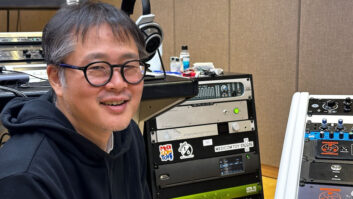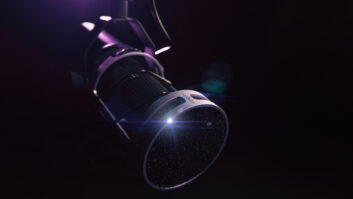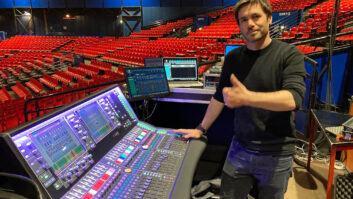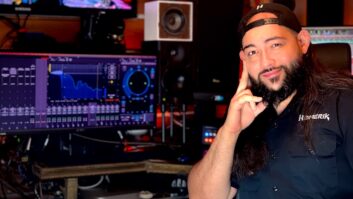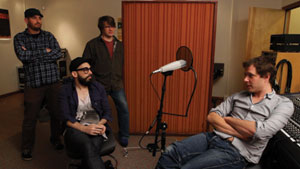
Left to right: Dan Konopka (drums/percussion), Tim Nordiwind (seated, bass/vocals), Dave Fridmann (engineer/producer), Damian Kulash (lead vocals/guitar).
Photo by Geoff Shelton
Out this month is Upside Out, a four-song OK Go EP that coincides with the use of one song, “The Writing’s on the Wall,” in the soundtrack for The Amazing Spiderman 2. This selection of bright, distorted synths and beat-heavy, yet diverse, electronic tracks comprises only a few of the songs upcoming on the band’s next full-length. Hungry Ghosts will drop this fall, along with, presumably, more of the group’s trademark destined-to-be viral videos.
All but one of these songs (Tony Hoffer produced the disco track “I Won’t Let You Down”) were made in a long series of sessions in producer/engineer Dave Fridmann’s rural New York studio, Tarbox Road, where work began with listening sessions. The bandmembers brought in about 40 demos to consider. Fridmann, drummer Dan Konopka, bassist Tim Nordwind, singer/guitarist Damian Kulash, and guitarist/keyboard player Andy Ross discussed broad strokes and small ones in determining what direction the album production, and specific sounds, should take.
They pared down the collection by about half and developed a system for sharing and fleshing out ideas in the studio: “We decided to work in a combination of Pro Tools and Reason,” Fridmann says. “That way, everything was elastic. Everything was synced up to a Reason track, so we could edit in both worlds, and we set up the studio with five different stations. We had the main A and B studios with my stuff, and three alternate rooms so all five of us had our own workspace.
“We’d just go from room to room,” Fridmann continues. “You’d work on whatever song you wanted for a while, and then you’d get tired or run out of ideas, and then you’d go listen to somebody else’s room for a while and make comments on what they were doing. Somebody else would be listening to your stuff and they’d give comments back. We just kept walking around the building in a circle, commenting on each other’s work and improving each other’s work.
“The tempo of everything, the arrangements of every song—it was completely up for grabs and completely dynamic, because we all had the same basic working environment, and it was easy to mix and match,” he continues. “Everything was completely nondestructive, as well, so everybody could be utterly fearless in their choices.”
Each musician had his own speakers and an Avid Mbox or Digi002 system, while Fridmann ran HD systems in his A and B studios. “Then we’d finally get to a point where we were ready to say, ‘Okay, we’ve got this idea for a track. Open that file in one of the HD systems and overdub a drum kit, and let’s keep working on it.”
In his HD rooms, Fridmann set up instrument-recording stations, with a handful of mics and pre’s ready and waiting. Lead and backing vocals, for example, were captured via a Neumann U 47 or Sennheiser 421. “I have a couple of older 421s from the ‘60s,” Fridmann says. “Those have a really interesting pushy sound. I also have a bunch of Neve 8801 mic pre’s that float around, and we used them wherever we needed them.”

Fridmann says guitar sounds were “all over the map. Damian has this really old Selmer amp, which is like a Vox AC30 with pushbuttons on top. It always sounds broken in the best way. He also uses a 1950s Princeton that only has one knob: Turn it up all the way, put a mic in front if it.” Fridmann’s go-to guitar mic on this project was a Bock 251.
“I would have to say, though, that a lot of the interesting sounds on this album originated inside of Reason,” Fridmann says. “We did a lot of programming, and that made it easy to transfer files; no matter what you did in a Thor synthesizer, you could take it to somebody else’s Reason station and it sounds the same. Then we could speed it up, slow it down, do whatever we want.”
Of the four songs on the EP, only “The Writing’s on the Wall” involved conventional basic tracking. “We had Tim and Andy both playing bass, and Dan on drums,” Fridmann says. “We spent a lot of time on bass, aiming for a heavily distorted sound, and in the long run we retracked both of those bass parts with an Ernie Ball StingRay bass. It just had to have that Cure kind of sound to it.”
Fridmann took the bass direct and miked the amp with an E-V RE27. “Most of the sound came from that Mesa Boogie cabinet; it’s an 810 with those Ampeg FlipTop SB12 heads,” he says.
Konopka’s kit was baffled off with gobos and curtains. “It was a pretty standard arrangement,” Fridmann says. “We put an E-V 868 on kick, and for some reason, I was using a Neumann 105 on top snare. Also, I have been favoring DPA 4006s for overheads. Nothing too crazy, but it was fun to track a live band because it was highly unusual for that session. We just knew that on this song, having them play together was the best way to tell whether our ideas were working.”
Much more common for these sessions was the musical dismantling Fridmann suggested for the album track “After the Fire”: “Damian brought in the demo that had real bass, real drums, real guitar, real singing, real piano,” Fridmann says. “It was a song. It was perfect. “And I was like, ‘You’ve done an amazing job. What I’m proposing is, you throw away everything that remotely sounds like music on it.’ And we did. It became random noise samples. We just kept following a lead of, ‘Let’s make this as unusual as we can.’ Not in an art-for-art’s-sake way, but we didn’t want to fall back on any simple answers to questions.”

